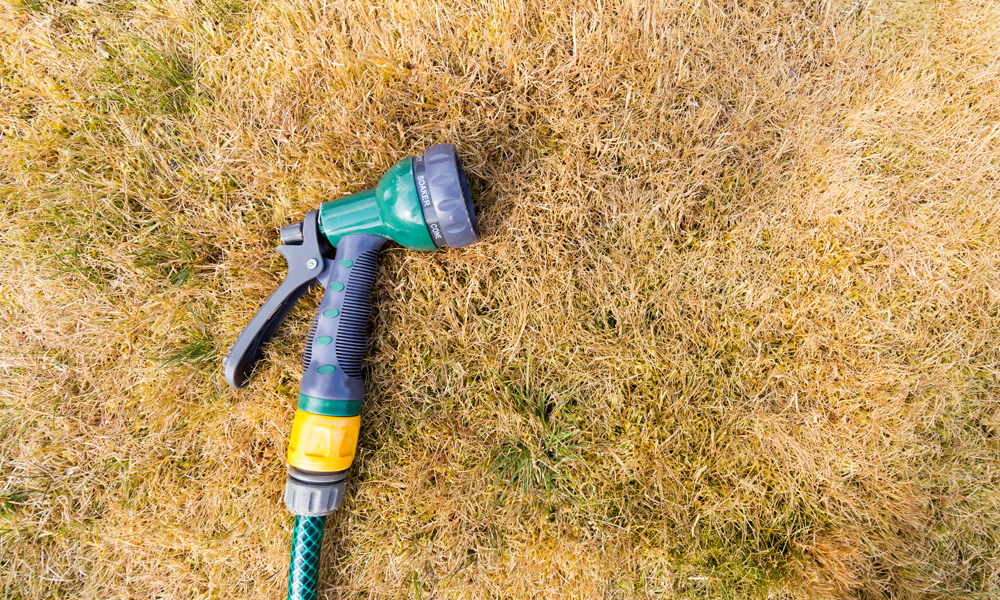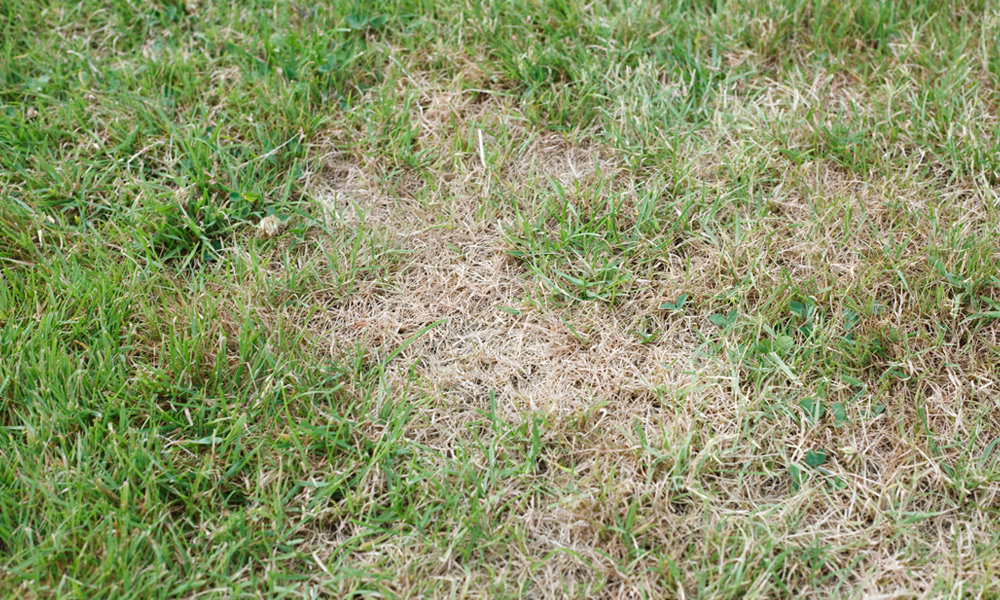How to Fix Patchy Grass: Causes, Solutions, and Maintenance Tips

It’s the middle of summer and you take a walk outside to enjoy your well-manicured lawn. But instead of a lush green carpet, you see brown patches dotting the landscape. Don’t worry – you’re not alone. Many homeowners deal with patchy grass every year. In this article, we will explore the different reasons why your lawn may be patchy, and how to fix it. We’ll also provide some tips on how to maintain your lawn after it has been repaired.
There’s nothing more irritating than a neatly trimmed lawn with sharp edges that reveal thinning grass in spots and bare brown patches. These ugly blemishes on your lawn can be caused by a number of different things. With a little investigation and some elbow grease, you can get rid of these unsightly patches and have a healthy, green lawn again.
What are the Causes of Brown Spots on the Lawn?
Let’s take a look at some of the possible causes for your patchy lawn before we get to the solutions. After all, it will be difficult to fix the problem if you don’t know what went wrong.
The main reasons for brown patches in your lawn are:
1. Lack of Water
One of the most common reasons for dead grass patches is a lack of water. If your lawn isn’t getting enough water, the grass will start to turn brown and die. This is especially true in hot, dry weather. Make sure you’re watering your lawn deeply and regularly to prevent this from happening.
2. Pests
Another possible cause of brown patches is pests. Insects, grubs, and other critters can wreak havoc on your lawn, causing the grass to die. If you suspect that pests are to blame for your patchy lawn, you should contact a pest control company for help.
3. Lawn Diseases
The disease can also be a factor when it comes to brown patches on your lawn. If you see spots that are yellow, red, or purple, this could be a sign of disease. Be sure to contact a professional if you suspect that your lawn is sick.
4. Fungus
The fungus can also cause brown patches on your lawn. If you see any mushrooms or other fungi growing on your lawn, this is a sure sign of a fungus problem. Fungi thrive in moist conditions, so be sure to water your lawn properly and keep it free of debris.
5. Soil Compaction
Brown patches on the lawn are also frequently caused by soil compacting. This happens when the soil is packed down too tightly, preventing air and water from getting to the roots of the grass. The best way to fix this problem is to aerate your lawn. This can be done with a hand aerator or a rental machine.
6. Not enough sunlight
Grass needs sunlight to grow, so if your lawn isn’t getting enough sun, it will start to thin out and die. If you have trees or other structures that are blocking the sun from reaching your lawn, you may need to trim them back.
7. Lack of Nutrients
The nutrients are very important for the health of your lawn. If the soil is lacking in nutrients, the grass will start to turn brown. The best way to fix this problem is to fertilize your lawn regularly.
8. Foot Traffic
Too much foot traffic can also cause brown patches on your lawn. If you have a high traffic area, such as a path to your front door, the grass will start to die from all the trampling. The best way to fix this problem is to create a walkway or path with pavers or other materials.
9. Improper Mowing
If you’re mowing your lawn too short, this can also cause brown patches. When the grass is cut too short, it doesn’t have enough leaves to produce food for the roots. This will cause the grass to slowly die. The best way to fix this problem is to raise the height of your lawnmower.
10. Pets’ misbehaviour
Sometimes your pets can be the reasons for brown or dead patches on our lawn. If they dig holes in the ground or urinate on the grass, it will surely kill the plants and the grass will start to turn brown. The best way to avoid this is by training your pets to go to the bathroom in a designated area away from your lawn.
When is the best time to fix your patchy lawn?
The best time to fix your patchy lawn is in the spring. This is because the grass will be actively growing and will be able to quickly fill in any bare spots. However, you can also seed your lawn in the fall. The grass may not grow as quickly, but it will still be able to establish itself before winter.
How to get rid of small brown spots on the lawn
There are a few different ways that you can get rid of small brown spots on your lawn. One way is to simply rake out the dead grass and replace it with a new seed or to lay Artificial Grass down. Another way is to use a product like Turf Builder to fill in the bare spots.
Repair small patches with grass seeds
The best way to repair small patches of grass is to simply sow some new seeds. You can do this by hand or with a seed spreader. Be sure to use a quality seed that is suited for your climate.
1. Germinate the seeds
This is an option, but it’s best to perform it inside a container with moist compost and cover it with cling film at temperatures no higher than 15°C. Wait until the white roots have appeared.
2. Prepare the sowing area
Before you sow the seeds, you will need to prepare the area. This involves removing any dead grass and loosening up the soil. You can do this with a rake or a hoe.
3. Sprinkle the seeds
Once the area is prepared, you can sprinkle the seeds onto the soil. Be sure to sow them thickly so that they have a good chance of germinating.
4. Cover the seeds
After you have sown the seeds, you will need to cover them with a thin layer of soil. This helps to protect them from birds and other animals.
5. Water the seeds
Once you have covered the seeds, you will need to water them regularly. Be sure to keep the soil moist, but not too wet. The seeds should start to germinate within 10-14 days.
Repair small patches using turf
If you have small bare patches of dead grass on your lawn, you can also repair them by using turf. You can buy turf from a garden centre or online. To install the turf, first, remove any dead grass and weeds from the area. Then, level the ground and compact it. Next, lay the turf in the prepared area and cut it to fit. Finally, water the turf and keep it moist until it is established.

Maintaining Your Lawn After Repairs
Once you have repaired your patchy lawn, you need to maintain it to prevent further damage. Some of the tips for maintaining your lawn include:
1. Watering Your Lawn
One of the most important things you can do for your lawn is to water it regularly. Be sure to water early in the morning so that the new grass has time to dry before nightfall. Watering in the evening can cause disease problems.
2. Proper Fertilization
Fertilizing your lawn is also important. Be sure to use a fertilizer that is suited for your grass type. Apply the fertilizer according to the manufacturer’s instructions.
3. Mowing Your Lawn
Mowing your lawn regularly is also important. Be sure to mow at the proper height for your grass type. Also, be sure to use a sharp mower blade. A dull blade can tear the grass and damage the lawn.
4. Aerating Your Lawn
Aerating your lawn helps to improve the drainage and allows air and water to reach the roots of the grass. Aerate your lawn in the spring and fall.
5. Controlling Weeds
Weeds can also damage your lawn. Be sure to control them by pulling them or using a herbicide.
6. Reseeding Your Lawn
If you have areas of your lawn that are bare, you may need to reseed them. Be sure to use a grass seed that is suited for your climate and soil type.
7. Liming Your Lawn
If your soil is too acidic, you may need to lime your lawn. Be sure to have your soil tested before adding lime. Apply the lime according to the manufacturer’s instructions.
8. Add Mulch to Your Flower beds
Adding mulch to your flower beds will help to control weeds and retain moisture. Be sure to use a mulch that is suited for your climate.
By following these tips, you can keep your lawn healthy and prevent patchy grass.
Bottom Line
Patchy grass is a common problem that can be caused by a variety of factors. The best way to fix patchy grass is to identify the cause and then take steps to correct it. Be sure to also water, fertilize, and mow your lawn regularly to prevent further damage. If you have patchy grass, don’t despair. With a little effort, you can have a healthy, green lawn in no time.
We hope you found this article helpful. If you have any questions, please feel free to leave a comment below. Thanks for reading!
